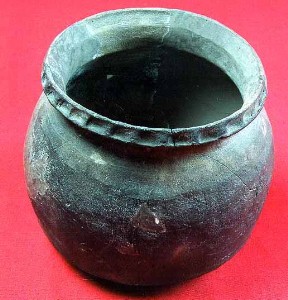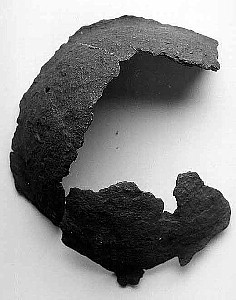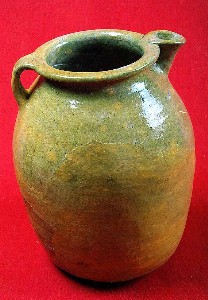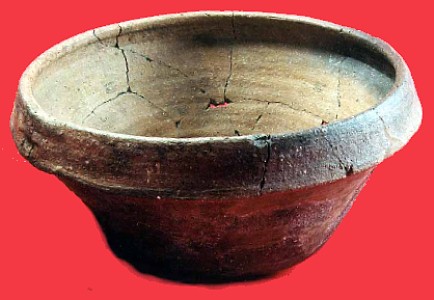|
|
Four Late Saxon Cooking and Serving Vessels from Oxford: 11th century AD |

Coarse Clay Cooking-Pot from St Ebbe’s
|  Fragmentary Iron Cooking-Pot from Cornmarket Street
|  Glazed Pitcher from St Ebbe’s
| 
Bowl of Calcite-Gritted Pottery from Church Street |
Family life in the long, narrow, single-storey timber buildings which lined the dirt streets of Oxford at the time of the Norman Conquest, centred around a large central open hearth. The smoke from the hearth was drawn up through an opening in the ridge of the house, warming and blackening the contents and occupants of the household.
Cooking vessels from excavations in St Ebbe’s, the south-west quarter of old Oxford now mostly covered by the Westgate Centre and multi-storey car park, were mostly made of clay, were of moderate size (one meal for a nuclear family), and were designed for long, slow cooking in the embers. Mixtures of various grains and water or milk, the ancestors of our modern oatmeal breakfast, were a dietary staple. This jar-shaped pot in a sandy fabric would have been perfect for cooking such a meal overnight. The rough fabric would not have been easy to wash, but in the slow cooking method, food does not normally burn and stick to the pot.
Finds of metal vessels from the 11th century are extremely rare, so these two fragments of an iron cooking vessel from Cornmarket Street give us valuable evidence. The little cauldron would have been rounded, with a simple handle, and looks very simply made, perhaps locally by itinerant smiths, to the household’s requirements. The handle suggests it was suspended over the fire, perhaps on a make-shift tripod: small pieces of meat, and sauces, could have been cooked in this way.
Between Roman and Norman times only one pottery centre in England produced glazed pottery successfully. This was Stamford in Lincolnshire, where the local fine light-coloured clay made it possible to produce delicate forms with clear lead glazes in pastel shades several centuries before this was possible elsewhere in the country.
Most Late Saxon pots were cooking vessels; serving vessels like this pitcher were comparatively rare, and the rounded base seems more suited to an earthen floor than to a wooden table, suggesting that many family meals in 11th-century Oxford may still have been taken sitting on the floor or on stools around the fire, rather than more formally at a table.
The pitcher could have held water from the river, ale or mead (wine made from honey).
Almost as many bowls as pots were used for cooking at the central hearths of houses in Late Saxon Oxford. The outside of the rim and the rounded base of this bowl are fire-blackened, suggesting that it was used to slow-cook or warm food in the embers; or upside-down for covering unleavened breads (like scones and pancakes, still very popular in Britain today) being cooked directly on the hearth.
© 1998 Oxfordshire Museum Service, Setúbal Museums and the Benaki Museum